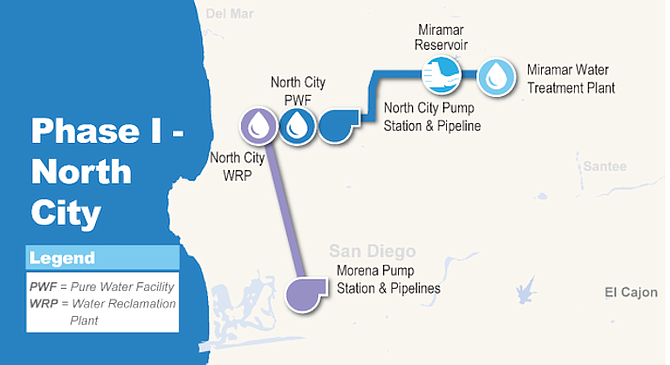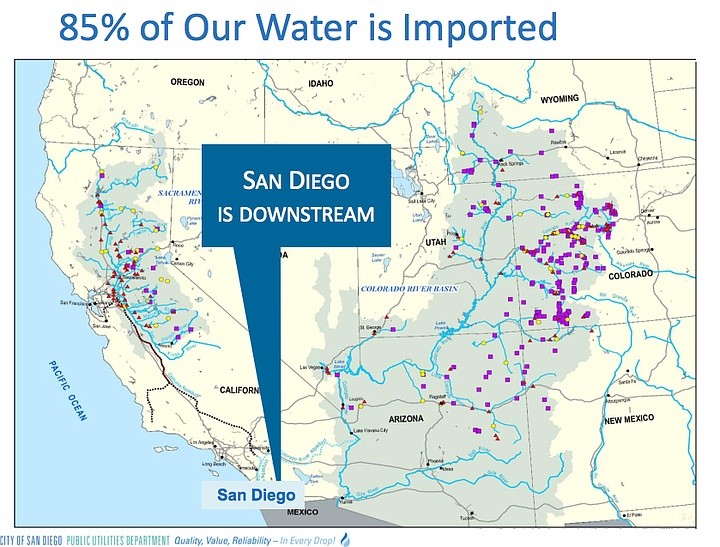 Facebook
Facebook
 X
X
 Instagram
Instagram
 TikTok
TikTok
 Youtube
Youtube

The city of San Diego’s plans to pump purified water into Lake Miramar is running into trouble with fishing aficionados who like to lure large-mouth bass at the lake.

“Over time, pumping reclaimed potty water into the lake is going to wipe out the phytoplankton and everything up the food chain, including the bass,” says Joe Kling, the 2016 president of the San Diego Council of Bass Clubs. “The problem is it is very sterile water that will not sustain fish because it contains no nutrients — that’s good for people, but not for the fish that live in the lake.”
So far, nearly 700 people have signed an online petition that asks the city to preserve the reservoir’s habitat for fishing.
“Despite its small size, Miramar Reservoir has historically been known as one of the premier trophy largemouth bass fishing lakes in the world. In fact, Miramar has produced five of the top 25 largest bass ever caught. Anglers from all over the world travel to San Diego to fish this legendary reservoir,” the petition says.
According to the petition, the California Department of Fish and Wildlife had expressed concern over the earlier plan to pump the purified water into the San Vicente and Lower Otay reservoirs, before the city revised the plan so that most of the water would be stored at Miramar.
(Fish and Wildlife was unable to confirm or deny they made the statement in responses to repeated attempts starting July 26.)
The city is in the process of wrapping up its draft environmental impact report for the pure water plant just north of La Jolla Village Drive, near the 805.
Many of the lakes in San Diego county, including Miramar, Lower Otay, San Vicente and Murray, are actually manmade reservoirs that serve as recreation sites. Some, including Miramar, are stocked with fish that have been imported.
The pure water demonstration plant first began producing one million gallons a day, water that’s been tested more than 28,000 times to be sure it is safe and clean. City officials are now preparing to build the first full-sized plant, expected to produce 30 million gallons a day of pure water by 2021, according to the city’s website.
The plans are for the purified water to be pumped into Lake Miramar to ‘cool off’ for 30 days before its final testing and treatment at the drinking water plant. Then it will be piped to people’s homes.
What the fishing community is worried about is that the water is too pure, Kling says.
“Natural water has phytoplankton that supports algae that supports the habitat that supports fish and wildlife around the lake,” he explained. “In five or six years after they start pumping pure water in, we expect that the fish will all die off.”
Kling says that the fisher folks don’t oppose reclaiming wastewater.
“It’s a good idea to reduce our dependence on imported water and that’s a big chunk of water that we can stop importing,” he said. “It’s just not clear why, when they are already purifying and sterilizing the water why they would put it in the lake so they have to purify it again. It’s expensive to do that twice. Why not just put it in the pipes to people?”
At a recent presentation, the fishing community challenged the plan to pump purified water to mix in the lake and then re-treat the water; and they asked that the environmental impact report look at the effects on the lakes.
“The city is interested in water. That’s what they do,” Kling said. “They don’t care about fishing; it’s not what they do.”
The draft EIR/EIS should be available in September with the city’s analysis and will take comments on the project that will be considered in the final draft.
Eventually, Lower Otay, Murray and San Vicente reservoirs may receive the purified water, he noted.
Kling said that the fishing groups were told that the 30-day storage in the reservoirs is required by a state agency. While he applauds the city’s initiative in reclaiming water, he thinks it can be done in a way that doesn’t wipe out the fish, and the recreation that thousands of San Diegans enjoy.
“You need the fish poop. You need the duck poop. You need the plankton and the various algae,” Kling said. “Everything depends on the water having nutrients in it.”


The city of San Diego’s plans to pump purified water into Lake Miramar is running into trouble with fishing aficionados who like to lure large-mouth bass at the lake.

“Over time, pumping reclaimed potty water into the lake is going to wipe out the phytoplankton and everything up the food chain, including the bass,” says Joe Kling, the 2016 president of the San Diego Council of Bass Clubs. “The problem is it is very sterile water that will not sustain fish because it contains no nutrients — that’s good for people, but not for the fish that live in the lake.”
So far, nearly 700 people have signed an online petition that asks the city to preserve the reservoir’s habitat for fishing.
“Despite its small size, Miramar Reservoir has historically been known as one of the premier trophy largemouth bass fishing lakes in the world. In fact, Miramar has produced five of the top 25 largest bass ever caught. Anglers from all over the world travel to San Diego to fish this legendary reservoir,” the petition says.
According to the petition, the California Department of Fish and Wildlife had expressed concern over the earlier plan to pump the purified water into the San Vicente and Lower Otay reservoirs, before the city revised the plan so that most of the water would be stored at Miramar.
(Fish and Wildlife was unable to confirm or deny they made the statement in responses to repeated attempts starting July 26.)
The city is in the process of wrapping up its draft environmental impact report for the pure water plant just north of La Jolla Village Drive, near the 805.
Many of the lakes in San Diego county, including Miramar, Lower Otay, San Vicente and Murray, are actually manmade reservoirs that serve as recreation sites. Some, including Miramar, are stocked with fish that have been imported.
The pure water demonstration plant first began producing one million gallons a day, water that’s been tested more than 28,000 times to be sure it is safe and clean. City officials are now preparing to build the first full-sized plant, expected to produce 30 million gallons a day of pure water by 2021, according to the city’s website.
The plans are for the purified water to be pumped into Lake Miramar to ‘cool off’ for 30 days before its final testing and treatment at the drinking water plant. Then it will be piped to people’s homes.
What the fishing community is worried about is that the water is too pure, Kling says.
“Natural water has phytoplankton that supports algae that supports the habitat that supports fish and wildlife around the lake,” he explained. “In five or six years after they start pumping pure water in, we expect that the fish will all die off.”
Kling says that the fisher folks don’t oppose reclaiming wastewater.
“It’s a good idea to reduce our dependence on imported water and that’s a big chunk of water that we can stop importing,” he said. “It’s just not clear why, when they are already purifying and sterilizing the water why they would put it in the lake so they have to purify it again. It’s expensive to do that twice. Why not just put it in the pipes to people?”
At a recent presentation, the fishing community challenged the plan to pump purified water to mix in the lake and then re-treat the water; and they asked that the environmental impact report look at the effects on the lakes.
“The city is interested in water. That’s what they do,” Kling said. “They don’t care about fishing; it’s not what they do.”
The draft EIR/EIS should be available in September with the city’s analysis and will take comments on the project that will be considered in the final draft.
Eventually, Lower Otay, Murray and San Vicente reservoirs may receive the purified water, he noted.
Kling said that the fishing groups were told that the 30-day storage in the reservoirs is required by a state agency. While he applauds the city’s initiative in reclaiming water, he thinks it can be done in a way that doesn’t wipe out the fish, and the recreation that thousands of San Diegans enjoy.
“You need the fish poop. You need the duck poop. You need the plankton and the various algae,” Kling said. “Everything depends on the water having nutrients in it.”
Comments